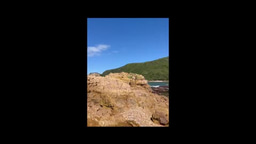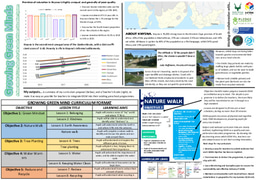Growing Green Minds: A New Model of Curriculum for the South African Education System
Introduction and Background
My Laidlaw Leadership in Action project was based in Knysna, South Africa. Knysna is a 76,000-strong town in the Western Cape province, with a rich diversity of cultures and ethnicities. 43% of the population is Black African; 37% are coloured; 0.5% are Indian/Asian; and 18% are white. Afrikaans is spoken by 46% of the population as a first language, whilst 34% speak Xhosa, and 15% speak English.
The project followed on from my scholarship-funded work last year, which supported the Knysna Education Trust (KET), an NGO assisting Early Childhood Development in schools across socio-economically deprived parts of town. The provision of education in Knysna is highly unequal, and generally of poor quality. Knysna’s learner retention rates are the second worst in the Western Cape, at only 55%, which marked a 4.2% reduction in learner retention from 2018. Learner enrolment of 0–14-year-olds in Knysna is below the 1.1% average for the Western Cape, at 0.9%. Knysna also has the fourth lowest proportion of no-fee schools in the region – these are the schools which KET supports, and the schools which my project focussed on.
My Leadership in Action project
My work in South Africa last year (summer 1 of the Laidlaw Scholarship) involved researching, writing, and presenting an eco-curriculum for Grade R children (aged 5-6) across schools receiving KET’s support. My curriculum – entitled ‘Growing Green Minds’ – was designed to be taught in conjunction with the existing preschool timetable, whilst hitting key physical and cognitive milestones for the children. The curriculum covered eight lesson plans, formatted into five environmental objectives – with each objective covered, the children developed a better understanding of the Earth (along with their place in, and where Earth fits into the wider universe), knowledge of trees and their importance, the role of the water cycle (and how to keep water clean), and how children could reduce or recycle their waste. This was underpinned by the children building a fundamental understanding of belonging – creating a sense of “my” world and where “I” fit in – and kindness, to the planet, animals, and each other. The result was a cross-cultural, cross-language, low-cost curriculum, which met fine motor and sensory development needs for children aged 5-6.
My work this year (summer 2 of the Laidlaw Scholarship) developed my curriculum, where I created lesson plans for Grade 3 children (aged 8-9), whilst maintaining the eco-learning outcomes from my curriculum for Grade R children. For example, for ‘Lesson 1: Belonging’, whilst my first curriculum developed a sense of place for Grade R children at the most basic level, the second curriculum introduced Grade R children to notions of countries and continents. Other lessons covered:
- Lesson 2: Kindness. This lesson established a link between kindness and a prosperous natural environment for the children. It explored how kindness to the planet (or a lack of) is manifested by plants and animals: successful crop growth can be the product of kindness to the planet, whilst natural disasters (including the 2017 Knysna wildfires) can be the consequence of irresponsible human consumption.
- Lesson 3: Earth Awareness. This lesson develops the children’s conceptualisation of the solar system, and how the world’s understanding of planets has grown through space exploration. The lesson also introduces children to the idea of extinction (as an expression of nature being unhappy, through a lack of human kindness), and encourages thinking around what can be done to mitigate this (including the importance of an uninterrupted food chain).
- Lesson 4: This lesson affirms the children’s knowledge of the different types of trees around them. It introduces children to the negative impacts of deforestation on animals and indigenous communities, but also explains where sustainable deforestation is necessary, for building material and fuel.
- Lesson 5: Water. This lesson explores how water exists in different stores and states of matter – from puddles and glaciers, to condensed droplets on windows and boiling water from a kettle. It teaches children a more advanced description of the water cycle, explaining why clouds form, what the equator is, and why hail falls. The lesson also introduces children to the relationship between the stormwater drainage system and plastic pollution, illustrating the journey of waste from drains to rivers, and eventually oceans.
- Lesson 6: Keeping Water Clean. This lesson highlights to dangers of polluted water to public health and natural life. It forms a connection between sea animals and humans in the food chain, illustrating how plastic straws thrown into the township streets can end up in the fish we eat.
- Lessons 7 and 8: Reduce and Recycle. These lessons introduce children to recycling, reducing waste, and reusing resources through low-cost methods. For example, ‘ecobricks’ – 2L plastic bottles filled with general waste, used to build structures from greenhouses to borders around vegetable patches, can be offered as a good example. These lessons also introduce children to the concept of biodegradable materials and renewable/non-renewable resources, highlighting that organic waste from families can be used by local farmers for fertiliser or animal feed.
Reflections and Lessons Learned
My project brought up several poignant reflections on ethical leadership, positive humanitarian intervention, and complex project delivery with limited resources. Such lessons have practical application in the charitable sector, but are also useful for any aspiring responsible global citizen. These reflections, in detail, can be found in my second post on the Laidlaw Scholars Network!


Please sign in
If you are a registered user on Laidlaw Scholars Network, please sign in